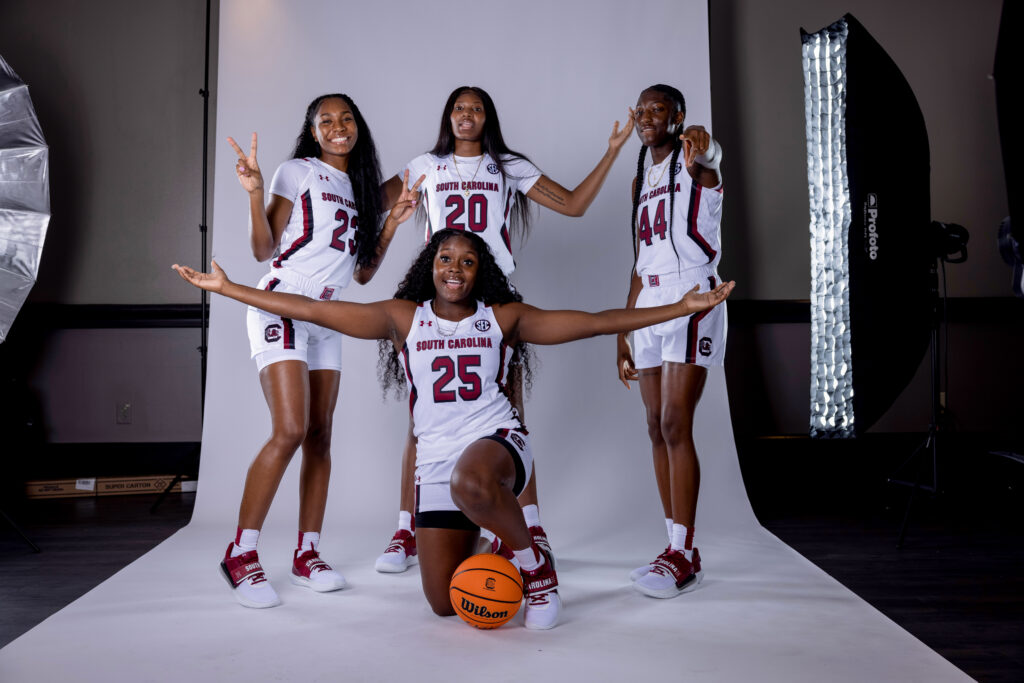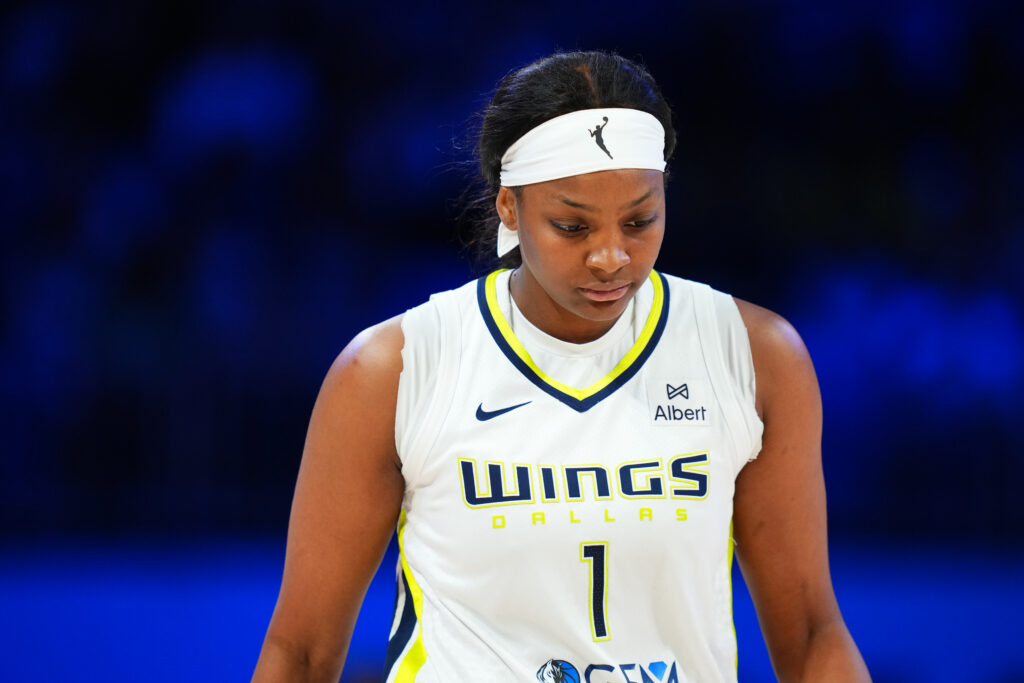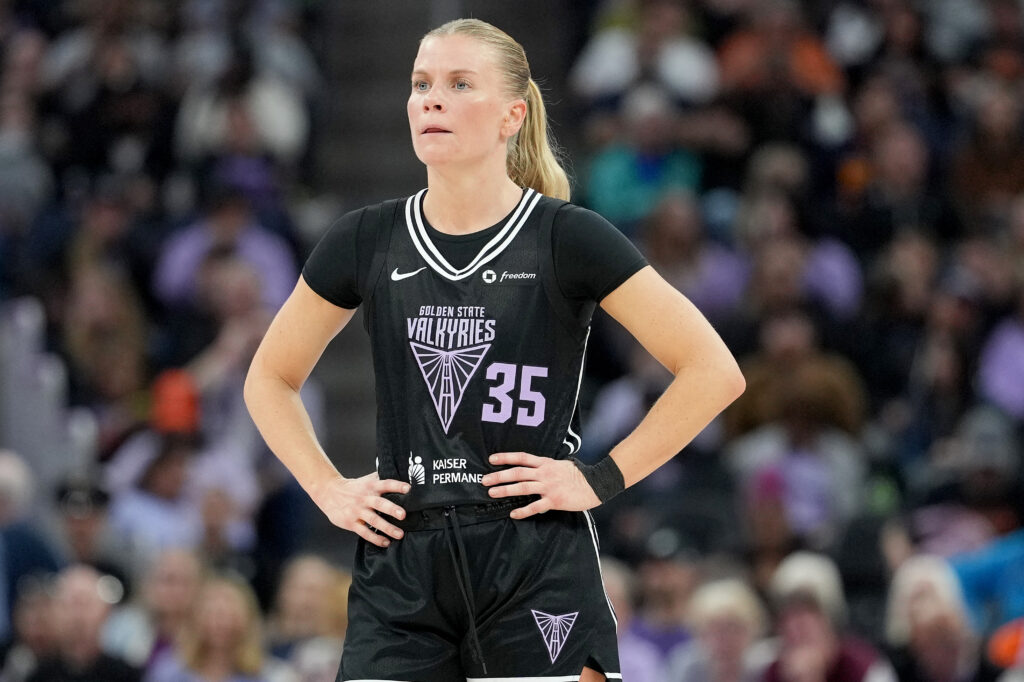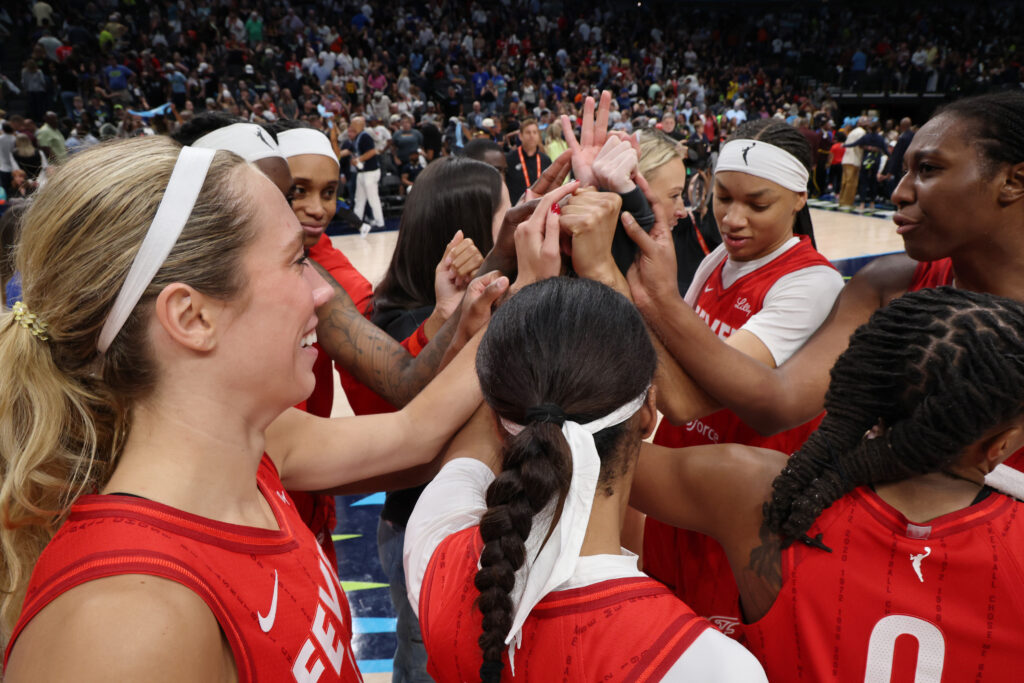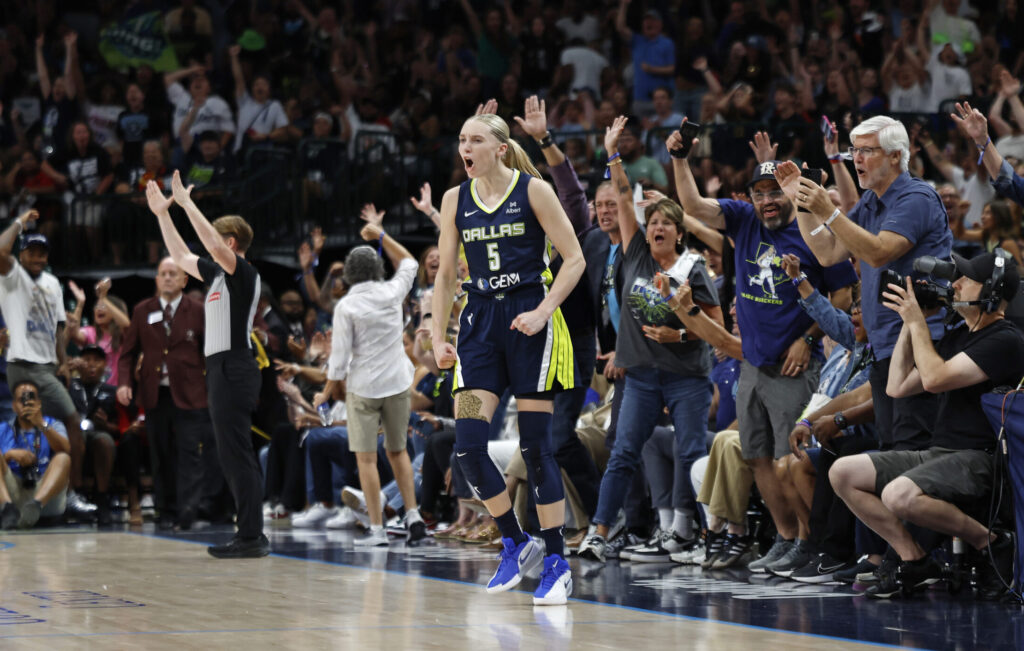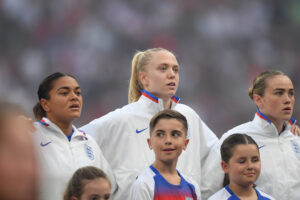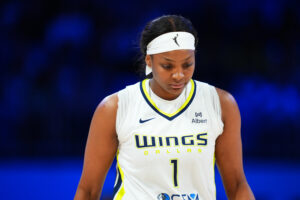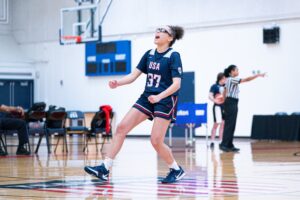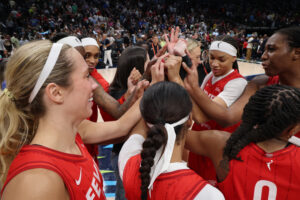When Bree Hall’s parents dropped her off at college, they didn’t cry. Neither did she. Everyone knew she was in good hands, and South Carolina had felt like home long before she stepped on campus.
“There was just so much confidence in where I was, there was nothing to cry about,” Hall says.
Hall was walking into a situation that would make any basketball player jealous. First, there’s the history of the Gamecocks women’s basketball program: a national title in 2017 and three Final Fours in the past seven years. Then there’s the present: a team with talented, experienced players like Aliyah Boston, Zia Cooke and Destanni Henderson, poised for a run at the national championship. And the future: at least seven more years of head coach Dawn Staley, whose value is priced at $22.4 million, but even that might be an undersell.
And if all of that isn’t enough to put a young hooper’s mind at ease, Hall and South Carolina’s three other freshmen can turn to a group chat affectionately named “The Fab Four.”
Staley eventually gave the moniker to South Carolina’s freshmen class, made up of Hall, Raven Johnson, Saniya Rivers and Sania Feagin. The nickname is a perfect description for the top-ranked recruiting class in women’s basketball this season, but when they started talking via text, the Fab Four wasn’t even the Fab Four yet. They were four high school seniors trying to weigh their options and pick the correct team and school.
Staley encouraged the players to talk even before they signed with the Gamecocks. The recruiting process can be an intimidating one. And unless a recruit has parents or siblings who went through the same thing, it can be isolating.
So Staley had a message for the recruits she hoped would one day become Gamecocks: Talk to each other, and help each other find the right fit, even if it’s not South Carolina.
“We all looked at our offers together and started doing pros and cons lists,” Rivers says.
Eventually, one school came out on top, and it was the same for all four of them.
“Next thing you know, we all committed at about the same time,” Rivers says.
When they did, the nickname came about, and Rivers, Feagin, Hall and Johnson renamed their group chat to reflect their newfound South Carolina identity.
Together they are Staley’s Fab Four, but separately, they are four individuals whose twists and turns led them down the same path.
Raven Johnson
There are two key pieces to Raven Johnson’s personality. The country’s No. 2-rated freshman (and No. 1 point guard) describes herself as a girly-girl who is also fiercely competitive. The first piece made her think she would hate basketball, and the second made her fall in love with the game.
“I was like, basketball is a boy’s sport. It’s too rough,” she says with a laugh. “But my grandpa told me, ‘You’re just not gonna do no cheerleading.’ ”
Raven’s grandfather took her and her twin brother, Richard, to the gym, where they played one-on-one. In that moment, Johnson’s competitive streak took over. She realized that she wanted to win, but not at just anything: She wanted to win at basketball.
“I was like, ‘Yeah, basketball is the sport for me,’ ” she says.
This year, however, Johnson will be playing cheerleader for her team after sustaining a season-ending knee injury against South Dakota on Friday.
But Gamecock fans might want to keep an eye on the sidelines to see what kind of street clothes Johnson is sporting. Because before she was one of the Fab Four, Johnson had another nickname, and it’s one she still uses: Hollywood.
During one of her first AAU practices as a tween, Johnson walked into the gym fresh off of a shopping spree at Justice.
“I was wearing glittery shoes — I think they were Chuck Taylors — glittery pants and a matching jacket to go with it. I just thought I was cute,” says the Atlanta native. “They took one look at me and said, ‘Yeah, your nickname is gonna be Hollywood.’ ”
She’s not wearing Justice anymore, but Johnson still embodies her nickname, so much so that she even has it in her Twitter handle. Hollywood likes anything beauty-related, she says. Lately she’s upgraded from Justice to Fashion Nova and takes pride in mixing up her look.
“I can go from wearing a dress to sweats and a cute little crop top,” she says. “I can wear pretty much anything as long as my hair is done and my face looks cute.”
Saniya Rivers
One of the first Christmas gifts Saniya Rivers remembers getting was a Fisher Price basketball hoop. The sport, she says, is in her blood. Her older sister Nanna Rivers played at North Carolina State, her dad played for a few years at Elon and her mom was a standout at UNC- Wilmington.
Rivers grew up in Wilmington, the town where Michael Jordan famously didn’t make his varsity team. So Rivers has been attached to basketball since the beginning, and it to her.
The No. 4 freshmen in the country received her first scholarship offer — from South Carolina — when she was in eighth grade.
Rivers was playing AAU for a team that coaches didn’t really have their eyes on, but she was tearing it up. On the last day of the tournament, Rivers was playing in the championship game and recognized Staley sitting in the front row.
“We ended up losing, but I got a phone call later that night with the offer, so that was big,” Rivers says.
For Rivers, South Carolina is step one in a plan she’s had since about the time she received that first offer. She has a love-hate relationship with her hometown. She’s received great support from people, but she’s also dealt with others trying to bring her down.
“All I’ve ever wanted growing up was to make it out and go to college and make it to the pro leagues,” Rivers says. “I want to give back to my city when I make it.”
Sania Feagin
For Sania Feagin, the choice to go to South Carolina wasn’t something she needed to think about; it was something she just knew was right.
“I put my trust to the Lord, and he guided me to where he felt was best for me,” she says.
Feagin grew up with faith and family as the cornerstones of her life. And through the two, basketball came naturally. When she was a young kid, her parents — who both competed collegiately — would play in various rec leagues, and when they finished, Feagin would run onto the court to get as many shots up as she could before they packed up and went home.
“I was ball-happy,” she says of her first days playing. “I would get it and just take off. I wanted to score.”
And basketball didn’t go away when they left the gym. Some of Feagin’s favorite memories are of playing in her driveway with her entire family — parents, siblings and even cousins. They’d play knockout, war, or adults vs. kids matchups. And even with a family full of collegiate athletes, they knew when to turn the competition off.
“Those games were always just fun,” Feagin says. “It was never doing nothing too much. We just had a good time.”
When she’s with her family, Feagin keeps things relatively low-key. Outside of basketball, one of her preferred hobbies is babysitting her 1-year-old nephew.
“When I was taking care of him before I came to school, he was so small and he would cry all the time,” she says. “He couldn’t even crawl. Now he barely even cries. He’s running around. He’s a handful.”
Bree Hall
When she was 6, Hall remembers playing sports with the kids in her neighborhood. It didn’t matter what the game was, because she loved them all. But when she picked up a basketball, parents and local coaches noticed. Hall was just having fun, but to those adults, she had a future in the game.
So as she grew, her dad, Bryan, started taking her to the gym to run drills. Unlike her fellow freshmen, who grew up with basketball players for parents, Bryan was just a helping hand and cheerleader for his daughter, the No. 14-ranked freshman this season.
“He was absolutely not a basketball player,” Bree says with a laugh. “He was that guy at the Y or the nearby gym that you would call, like, your local LeBron, but he never even played in high school.”
South Carolina first piqued the Ohio native’s interest when she was a sophomore in high school. Her AAU teammate, Zia Cooke, had committed to the Gamecocks, so Hall visited the school.
“I watched them play against UConn and they ended up winning,” Hall says. “And [Henderson’s] family was there, and they sat me down and gave me some good advice about the recruiting process and about how this was probably the place for me.”
The future of South Carolina
Once the Fab Four officially committed to South Carolina, the fun started.
They texted about serious things, like the COVID-19 pandemic that had marked all of their high school careers, but mostly the chat remained light-hearted.
“Before we had that group chat, we didn’t really know each other,” Hall says. “But before we got to campus, we were all so excited, talking about what colors we were going to have in our rooms and where we could get our nails and hair done.”
Hall, Feagin and Rivers live together, while Johnson lives with sophomore Kamilla Cardoso, her former AAU teammate who, as a transfer from Syracuse, is also new to the team.
Last year, the four freshmen watched as South Carolina made its way to the Final Four and lost a nail-biter to Stanford. They all agreed that watching the Gamecocks was surreal, and found themselves switching back and forth between cheering on their future teammates and trying to analyze where they might fit in on the court.
When they got to campus, fitting in with their teammates socially was a breeze. The Gamecocks like to listen to music together, have movie nights and occasionally break into ultra-competitive rounds of UNO.
“It’s not just on the court,” Rivers says. “Cards get thrown. It gets ridiculous.”
But transitioning from high school and even AAU ball to college basketball proves to be a lot more difficult than fitting in with a new group of friends.
But you don’t go to South Carolina expecting to easily slide into playing time.
“I’m going to be honest, high school and college are two different types of ball games,” says Johnson, who won four straight state championships at Westlake High School. “You have one or two players on the team who are really, really good, but in college the pace is different. You got more players, the whole team is good.”
Many skills players could pull off in high school suddenly don’t work in college. Rivers, for example, said she’s in the process of changing her shot because she noticed it getting blocked too much during preseason practices.
Until Johnson went down with a knee injury, she, Rivers, Feagin and Hall — four five-star recruits who had their pick of programs — were all fighting for a sliver of game action.
Because even before signing the best class in the country, South Carolina was already stacked. The Gamecocks not only returned their starting five, but also their sixth and seventh players off the bench. And they added the 6-7 Cardoso, one of the most sought-after transfers in the offseason.
So yeah, this is a whole different ball game, but it’s one the freshman class is ready for. They all know what coming to a program like South Carolina means. It’s not about instant college stardom, but the opportunity to play for a legendary coach and to compete with some of the country’s best players.
“I enjoy it because nothing is going to come easy,” Feagin says. “I know I’m going to have to work hard. Like for me, going against Aliyah [Boston] in practice every day is going to push me. Because she is bigger, stronger and more experienced than me. So that is going to make me a better me.”
Before long, Feagin will play the role of Boston for a new recruit. So will Rivers, Johnson and Hall. For now, they’re a group of talented freshmen. But soon, South Carolina basketball will belong to the Fab Four.
Eden Laase is a contributing writer at Just Women’s Sports. She previously ran her own high school sports website in Michigan after covering college hockey and interning at Sports Illustrated. Follow her on Twitter @eden_laase.
